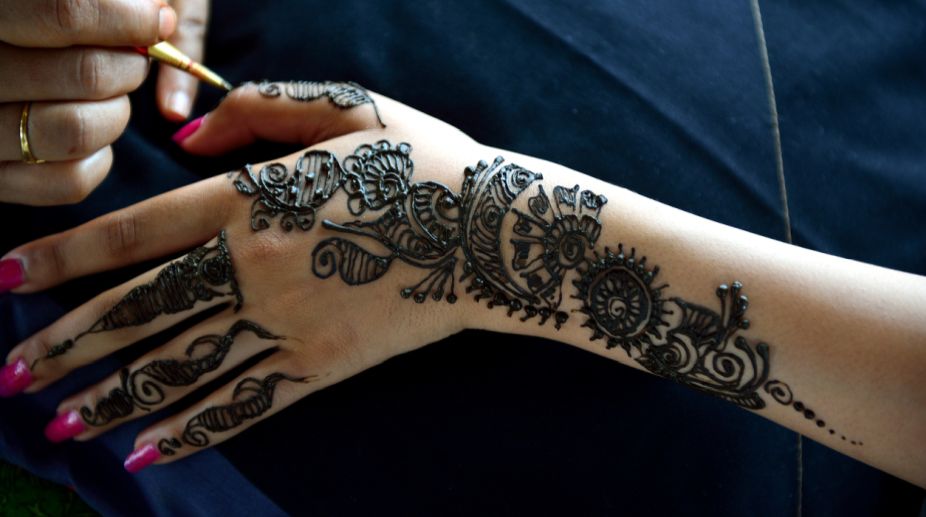Salman, joined by father Salim Khan, greets cheering crowds outside Galaxy Apts
As the twilight skyline lit up with mobile torch lights, Salman paced up and down his balcony with his trademark half smile and greeted the crowds.

(Photo: Getty Images)
A lucrative, high in demand business simmers out from the shadows every Eid. The applying of mehendi, or henna, becomes imperative and salons all across the country burn the midnight oil on the night before the festival, catering to hundreds of women who turn up en masse for their requisite hand-candy. A good amount of traffic crowds around popular salons and the strong smell of mehendi resiliently permeate the air.
Other than the two Eids, mehendi is also applied to the hands is during weddings. But while its demand may fluctuate through the year, mehendi application is a tradition deeply entrenched in local culture.The bride puts it on under the vague belief that the darker the shade of her mehendi, the more happily married she will be. And on festivals, mehendi application is considered an important, often expensive, requirement.
This does not mean, though, that mehendi is merely for the traditionalists. Internationally, henna can take on funky patterns; on Madonna, an “Om” symbol on the hand or dotted decoratively around her face, a Maori henna-inspired tattoo flaunted by Rihanna or a blue-haired Gwen Stefani with a paisley printed on her bare shoulder.
Advertisement
The usual mehendi customer, however, isn’t a big fan of the risque, having a penchant for routine winding trellises, multi-tiered florals and paisleys, trailing down the hand, stretching on to the wrists, decorating the back of the hand and then, the feet. The bona fide fanatic may also opt for a band to be etched on her upper arm, lower arm or around her ankle. This may result in the customer whiling her time away at the salon for hours but when it comes to mehendi, one has observed women showing admirable patience and an eagerness to sharply elbow any other who dares to usurp their turn with the exhausted (but fast getting rich) mehendi-waali. “Mehendi wars” on the night before Eid are a common, inevitable occurrence.
Also interesting are the slight changes in design being introduced by mehendi aficionados— a change in colour and some very distinctive patterns, for instance. Here are some of the trends that we’ve noticed:
Regular mehendi gives off a deep burgundy shade and can be beautiful when applied with finesse. However, innovations can be made with a change in colour. “Red mehendi” gives off a bright red hue which can be eye-catching. “Black mehendi” is often available as an option although it is not recommended since it contains dyes that can often lead to severe allergies. “White henna” — which is basically a paste that can be applied in the same way as genuine mehendi — can be used to make a stark unique statement. And if the mehendi-wearer is feeling adventurous, there are UV-henna tattoos that glow in the dark. Again, like black and white mehendi, the UV-paint isn’t actual henna but can be applied the same way as henna — in conventional patterns or avant-garde swirls.
Also, bling-lovers sometimes opt to have their mehendi tattoos ‘coloured in’ with glitter. This is not usually in good taste, with the mehendi-wearer acquiring a Midas touch of sorts, rubbing off glitter on whatever she touches.
African henna is purely for the bold-hearted, usually featuring geometric designs, thick borders and distinctive filigree patterns. Tribal patterns are common and the designs are usually “filled in” extensively, leaving a stark stain on the skin. Infusions of glitter are also common. Usually large, the African style often extends beyond hands, winding about the entire length of an arm or the lower leg.
In complete contrast to its African counterpart, Turkish mehendi is delicate and extremely intricate. Peacocks, paisleys, criss-crossing grids and spirals dominate designs that are quite similar to regular local motifs. However, while mehendi in the subcontinent is often ‘filled in’ in places, the Turkish style consists of thin, dense borders.
Largely popularised by pop-star Rihanna, Maori designs are a funky alternate to the usual henna patterns. Inspired by the Maori tribes of New Zealand, the patterns are distinctive; sharp zig-zags, pointy stars, fish hooks, mantises and artisticallyshaped fish, among others. The designs usually have symbolic interpretations: ‘water’-inspired designs speak of the balance between the spiritual and material world, fish hooks symbolise good fortune and heartshaped leaves are said to have healing energy!
Increasingly, one sees innovations in mehendi design via customisation. There are brides who shrug away the conventional mehendi motifs, opting for their love stories to be etched out on their hands, complete with skylines of places where they first met the groom, special mementos and important events. Enthusiasts are also seen steering their mehendi towards avant-garde territory — a “peace” sign, calligraphy, city skylines, prayer bead patterns printed down the wrist like a bracelet or even prints that emulate lacy gloves!
It’s fun, exciting and gives mehendi, hitherto always entrenched in tradition, a “cool”, young vibe that it never had before.
(Dawn/ ANN)
Advertisement